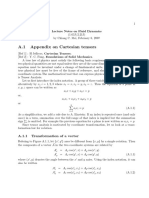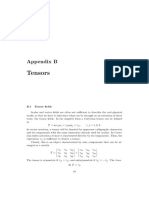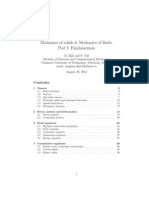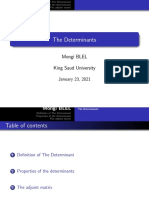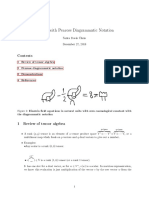Vectors and Tensors
Uploaded by
Andrei CioroianuVectors and Tensors
Uploaded by
Andrei CioroianuSection 1.
10
1.10 Special Second Order Tensors & Properties of Second Order Tensors
In this section will be examined a number of special second order tensors, and special properties of second order tensors, which play important roles in tensor analysis. The following will be discussed: The Identity tensor Transpose of a tensor Trace of a tensor Norm of a tensor Determinant of a tensor Inverse of a tensor Orthogonal tensors Rotation Tensors Change of Basis Tensors Symmetric and Skew-symmetric tensors Axial vectors Spherical and Deviatoric tensors Positive Definite tensors
1.10.1
The Identity Tensor
The linear transformation which transforms every tensor into itself is called the identity tensor. This special tensor is denoted by I so that, for example,
Ia = a for any vector a
In particular, Ie1 = e1 , Ie 2 = e 2 , Ie 3 = e 3 , from which it follows that, for a Cartesian coordinate system, I ij = ij . In matrix form,
1 0 0 [I ] = 0 1 0 0 0 1
(1.10.1)
1.10.2
The Transpose of a Tensor
The transpose of a second order tensor A with components Aij is the tensor A T with components A ji ; so the transpose swaps the indices,
A = Aij e i e j , A T = A ji e i e j Transpose of a Second-Order Tensor (1.10.2)
In matrix notation,
Solid Mechanics Part III
84
Kelly
Section 1.10
A11 A12 A13 [A] = A21 A22 A23 , A31 A32 A33
[A ]
T
A11 A21 A31 = A12 A22 A32 A13 A23 A33
Some useful properties and relations involving the transpose are {Problem 2}:
(A )
T T
=A
(A + B )T = A T + B T (u v )T = v u
Tu = uT T , uT = T T u = BT AT
(AB )T
(1.10.3)
A : B = AT : BT (u v ) A = u ( A T v ) A : (BC ) = B T A : C = AC T : B A formal definition of the transpose which does not rely on any particular coordinate system is as follows: the transpose of a second-order tensor is that tensor which satisfies the identity1
u Av = v A T u
(1.10.4)
tensor A is (A )ij . From Eqn. 1.9.4, (A )ij = e i Ae j and the components of the transpose can be written as A T
for all vectors u and v. To see that Eqn. 1.10.4 implies 1.10.2, first note that, for the present purposes, a convenient way of writing the components Aij of the second-order
(A )
T
ij
= e i A T e j = e j Ae i = (A ) ji = A ji .
( )
ij
= e i A T e j . Then, from 1.10.4,
1.10.3
The Trace of a Tensor
The trace of a second order tensor A, denoted by trA , is a scalar equal to the sum of the diagonal elements of its matrix representation. Thus (see Eqn. 1.4.2)
trA = Aii
Trace
(1.10.5)
A more formal definition, again not relying on any particular coordinate system, is
trA = I : A
Trace
(1.10.6)
note that, from the linearity of tensors, uA v = u Av ; for this reason, this expression is usually written simply as uAv
Solid Mechanics Part III
85
Kelly
Section 1.10
and Eqn. 1.10.5 follows from 1.10.6 {Problem 4}. For the dyad u v {Problem 5},
tr (u v ) = u v
Another example is
tr(E 2 ) = I : E 2 = ij (e i e j ) : E pq E qr (e p e r ) = Eiq E qi
(1.10.7)
(1.10.8)
This and other important traces, and functions of the trace are listed here {Problem 6}:
trA = Aii trA 2 = Aij A ji trA 3 = Aij A jk Aki (1.10.9)
(trA ) = Aii A jj (trA )3 = Aii A jj Akk
2
Some useful properties and relations involving the trace are {Problem 7}:
trA T = trA tr (AB ) = tr (BA ) tr (A + B ) = trA + trB tr (A ) = trA
(1.10.10)
A : B = tr A T B = tr AB T = tr B T A = tr BA T
The double contraction of two tensors was earlier defined with respect to Cartesian coordinates, Eqn. 1.9.14. This last expression allows one to re-define the double contraction in terms of the trace, independent of any coordinate system. Consider again the real vector space of second order tensors V 2 introduced in 1.8.5. The double contraction of two tensors as defined by 1.10.10e clearly satisfies the requirements of an inner product listed in 1.2.2. Thus this scalar quantity serves as an inner product for the space V 2 :
A, B A : B = tr A T B and generates an inner product space.
(1.10.11)
Just as the base vectors {e i } form an orthonormal set in the inner product (vector dot product) of the space of vectors V, so the base dyads {e i e j } form an orthonormal set in the inner product 1.10.11 of the space of second order tensors V 2 . For example,
Solid Mechanics Part III
86
Kelly
Section 1.10
e1 e1 , e1 e1 = (e1 e1 ) : (e1 e1 ) = 1
(1.10.12)
Similarly, just as the dot product is zero for orthogonal vectors, when the double contraction of two tensors A and B is zero, one says that the tensors are orthogonal,
A : B = tr (A T B ) = 0 ,
A, B orthogonal
(1.10.13)
1.10.4
defined by
The Norm of a Tensor
Using 1.2.8 and 1.9.10, the norm of a second order tensor A, denoted by A (or A ), is
A = A:A
(1.10.14)
This is analogous to the norm a of a vector a,
aa .
1.10.5
The Determinant of a Tensor
The determinant of a second order tensor A is defined to be the determinant of the matrix [A] of components of the tensor:
A11 A12 det A = det A21 A22 A31 A32 = ijk Ai1 A j 2 Ak 3 = ijk A1i A2 j A3k
A13 A23 A33 (1.10.15)
Some useful properties of the determinant are {Problem 8}
det( AB) = det A det B det A T = det A det (u v ) = 0 pqr (det A ) = ijk Aip A jq Akr det(A ) = 3 det A
(1.10.16)
(Ta Tb ) Tc = (det T)[(a b ) c]
Note that det A , like trA , is independent of the choice of coordinate system / basis.
Solid Mechanics Part III
87
Kelly
Section 1.10
1.10.6
The Inverse of a Tensor
The inverse of a second order tensor A, denoted by A 1 , is defined by AA 1 = I = A 1 A (1.10.17)
The inverse of a tensor exists only if it is non-singular (a singular tensor is one for which det A = 0 ), in which case it is said to be invertible. Some useful properties and relations involving the inverse are:
( A 1 ) 1 = A (A) 1 = (1 / ) A 1 ( AB) 1 = B 1 A 1 det( A 1 ) = (det A) 1 Since the inverse of the transpose is equivalent to the transpose of the inverse, the following notation is used: (1.10.18)
A T ( A 1 ) T = ( A T ) 1
(1.10.19)
1.10.7
Orthogonal Tensors
An orthogonal tensor Q is a linear vector transformation satisfying the condition
Qu Qv = u v
(1.10.20)
for all vectors u and v. Thus u is transformed to Qu , v is transformed to Qv and the dot product u v is invariant under the transformation. Thus the magnitude of the vectors and the angle between the vectors is preserved, Fig. 1.10.1.
u
v
Qv
Qu
Figure 1.10.1: An orthogonal tensor
Since
Qu Qv = uQ T Qv = u Q T Q v
(1.10.21)
Solid Mechanics Part III
88
Kelly
Section 1.10
it follows that for u v to be preserved under the transformation, Q T Q = I , which is also used as the definition of an orthogonal tensor. Some useful properties of orthogonal tensors are{Problem 10}:
QQ T = I = Q T Q, Q 1 = Q T det Q = 1 Qik Q jk = ij = Qki Qkj
(1.10.22)
1.10.8
Rotation Tensors
If for an orthogonal tensor, det Q = +1 , Q is said to be a proper orthogonal tensor, corresponding to a rotation. If det Q = 1 , Q is said to be an improper orthogonal tensor, corresponding to a reflection. Proper orthogonal tensors are also called rotation tensors.
1.10.9
Change of Basis Tensors
Consider a rotation tensor Q which rotates the base vectors e1 , e 2 , e 3 into a second set, , e2 , e e1 3 , Fig. 1.10.2.
e i = Qe i
i = 1, 2, 3
(1.10.23)
Such a tensor can be termed a change of basis tensor from {e i } to {e i } . The transpose T Q rotates the base vectors e e i back to e i and is thus change of basis tensor from { i } to {e i } . The components of Q in the e i coordinate system are, from 1.10.4, Qij = e i Qe j and so
Q = Qij e i e j , Qij = e i ej ,
(1.10.24)
which are the direction cosines between the axes (see Fig. 1.5.5).
e3
e 3
e2
e2
Q
e1
e1
Figure 1.10.2: Rotation of a set of base vectors
The change of basis tensor can also be written in the explicit form
Solid Mechanics Part III
89
Kelly
Section 1.10
Q = e i ei
(1.10.25)
T from which the above relations can easily be derived, for example e i = Qe i , QQ = I , etc.
Consider now the operation of the change of basis tensor on a vector:
Qv = vi (Qe i ) = vi e i
(1.10.26)
Thus Q transforms v into a second vector v , but this new vector has the same components with respect to the basis e i , as v has with respect to the basis e i , v i = v i .
Example
Consider the two-dimensional rotation tensor
0 1 Q= i ei (e i e j ) e + 1 0
which corresponds to a rotation of the base vectors through / 2 . The vector v = [1 1] then transforms into (see Fig. 1.10.3)
T
1 + 1 Qv = e i = e i + 1 + 1
Qv
e2 e1
e2
e1
Figure 1.10.3: a rotated vector Similarly, for a second order tensor A, the operation
QAQ T = Q(Aij e i e j )Q T = Aij Qe i e j Q T = Aij (Qe i Qe j ) = Aij e i ej
(1.10.27) results in a new tensor which has the same components with respect to the e i , as A has = Aij . with respect to the e i , Aij
Solid Mechanics Part III
90
Kelly
Section 1.10
1.10.10 Symmetric and Skew Tensors
A tensor T is said to be symmetric if it is identical to the transposed tensor, T = T T , and skew (antisymmetric) if T = T T . Any tensor A can be (uniquely) decomposed into a symmetric tensor S and a skew tensor W, where
1 A + AT 2 1 skewA W = A A T 2 symA S =
) )
(1.10.28)
and S = ST , In matrix notation one has W = W T (1.10.29)
S11 S12 S13 [S ] = S12 S 22 S 23 , S13 S 23 S 33
W12 W13 0 [W ] = W12 0 W23 0 W W 23 13
(1.10.30)
Some useful properties of symmetric and skew tensors are {Problem 13}:
T S : B = S : BT = S : 1 2 B+B
W : B = W : B = W :
T
1 2
( B )
T
S:W = 0
tr (SW ) = 0 v Wv = 0
(1.10.31)
det W = 0
(has no inverse)
where v and B denote any arbitrary vector and second-order tensor respectively. Note that symmetry and skew-symmetry are tensor properties, independent of coordinate system.
1.10.11 Axial Vectors
A skew tensor W has only three independent coefficients, so it behaves like a vector with three components. Indeed, a skew tensor can always be written in the form
Wu = u
(1.10.32)
Solid Mechanics Part III
91
Kelly
Section 1.10
where u is any vector and characterises the axial (or dual) vector of the skew tensor W. The components of W can be obtained from the components of through
Wij = e i We j = e i ( e j ) = e i ( k e k e j ) = e i ( k kjp e p ) = kji k = ijk k
(1.10.33)
If one knows the components of W, one can find the components of by inverting this equation, whence {Problem 14} = W23e1 + W13 e 2 W12 e 3
Example (of an Axial Vector)
(1.10.34)
Decompose the tensor
1 2 3 T = Tij = 4 2 1 1 1 1
[ ]
into its symmetric and skew parts. Also find the axial vector for the skew part. Verify that Wa = a for a = e1 + e 2 . Solution One has
1 2 3 1 4 1 1 1 1 T S = T + T = 4 2 1 + 2 2 1 = 3 2 2 2 3 1 1 1 1 1 1 2 3 1 4 1 0 1 1 T 2 2 1 + W = T T = 4 2 1 =1 2 2 1 1 1 1 3 1 1
3 2 2 1 1 1 1 1 0 0 0 0
The axial vector is = W23 e1 + W13 e 2 W12 e 3 = e 2 + e 3 and it can be seen that
Wa = Wij (e i e j )(e1 + e 3 ) = Wij ( j1 + j 3 )e i = (Wi1 + Wi 3 )e i
= (W11 + W13 )e1 + (W21 + W23 )e 2 + (W31 + W33 )e 3 = e1 + e 2 e 3
Solid Mechanics Part III
92
Kelly
Section 1.10
and
e1 e 2 a = 0 1 1 0
e3 1 = e1 + e 2 e 3 1
The Spin Tensor
The velocity of a particle rotating in a rigid body motion is given by v = x , where is the angular velocity vector and x is the position vector relative to the origin on the axis of rotation (see Problem 9, 1.1). If the velocity can be written in terms of a skewsymmetric second order tensor w , such that wx = v , then it follows from wx = x that the angular velocity vector is the axial vector of w . In this context, w is called the spin tensor.
1.10.12 Spherical and Deviatoric Tensors
Every tensor A can be decomposed into its so-called spherical part and its deviatoric part, i.e.
A = sphA + devA
(1.10.35)
where
sphA =
= 0 0 devA = A sphA
(trA )I ( A11 + A22 + A33 )
1 3 1 3 1 3
( A11 + A22 + A33 )
0
0 1 ( ) + + A A A 11 22 33 3 0
( A11 + A22 + A33 ) A12 A13 A11 1 3 1 A21 A22 3 ( A11 + A22 + A33 ) A23 = ( ) A31 A32 A33 1 3 A11 + A22 + A33 (1.10.36)
Any tensor of the form I is known as a spherical tensor, while devA is known as a deviator of A, or a deviatoric tensor. Some important properties of the spherical and deviatoric tensors are
tr (devA ) = 0 sph (devA ) = 0 devA : sphB = 0
(1.10.37)
Solid Mechanics Part III
93
Kelly
Section 1.10
1.10.13 Positive Definite Tensors
A positive definite tensor A is one which satisfies the relation
vAv > 0 ,
v o
(1.10.38)
The tensor is called positive semi-definite if vAv 0 . In component form,
2 vi Aij v j = A11v12 + A12 v1v 2 + A13 v1v3 + A21v 2 v1 + A22 v 2 +L
(1.10.39)
and so the diagonal elements of the matrix representation of a positive definite tensor must always be positive. It can be shown that the following conditions are necessary for a tensor A to be positive definite (although they are not sufficient): (i) (ii) (iii) (iv) the diagonal elements of [A ] are positive the largest element of [A ] lies along the diagonal det A > 0 Aii + A jj > 2 Aij for i j (no sum over i, j )
These conditions are seen to hold for the following matrix representation of a positive definite tensor:
2 2 0 [A] = 1 4 0 0 0 1
A necessary and sufficient condition for a tensor to be positive definite is given in the next section, during the discussion of the eigenvalue problem. One of the key properties of a positive definite tensor is that, since det A > 0 , positive definite tensors are always invertible. An alternative definition of positive definiteness is the equivalent expression
A:vv >0
(1.10.40)
1.10.14 Problems
1. Show that the components of the (second-order) identity tensor are given by I ij = ij . 2. Show that
Solid Mechanics Part III 94 Kelly
Section 1.10
(a) (u v ) A = u ( A T v ) (b) A : (BC ) = (B T A ) : C = (AC T ) : B 3. Use (1.10.4) to show that I T = I . 4. Show that (1.10.6) implies (1.10.5) for the trace of a tensor. 5. Show that tr (u v ) = u v . 6. Formally derive the index notation for the functions trA 2 , trA 3 , ( trA ) 2 , ( trA) 3 7. Show that A : B = tr ( A T B) . 8. Prove (1.10.16f), (Ta Tb ) Tc = (det T )[(a b ) c] . 9. Show that ( A 1 ) T : A = 3 . [Hint: one way of doing this is using the result from Problem 7.] 10. Use 1.10.16b and 1.10.18d to prove 1.10.22c, det Q = 1 . 11. Use the explicit dyadic representation of the rotation tensor, Q = e i e i , to show that x2 x3 , coordinate system are the same as the components of Q in the second, ox1 = e those in the first system [hint: use the rule Qij i Qe j ] 12. Consider the tensor D with components (in a certain coordinate system) 1 / 2 1 / 2 1 / 2 1/ 2 1/ 2 0 1 / 2 1 / 2 1 / 2
Show that D is a rotation tensor (just show that D is proper orthogonal). 13. Show that tr (SW ) = 0 . 14. Multiply across (1.10.32), Wij = ijk k , by ijp to show that = 1 2 ijk Wij e k . [Hint:
( ) 15. Show that 1 2 a b b a is a skew tensor W. Show that its axial vector is 1 = 2 (b a ) . [Hint: first prove that (b u )a (a u )b = u (a b ) = (b a ) u .] 16. Find the spherical and deviatoric parts of the tensor A for which Aij = 1 .
use the relation 1.3.19b, ijp ijk = 2 pk .]
Solid Mechanics Part III
95
Kelly
You might also like
- 1.10 Special Second Order Tensors & Properties of Second Order TensorsNo ratings yet1.10 Special Second Order Tensors & Properties of Second Order Tensors12 pages
- [Mathematical Engineering ] Mikhail Itskov - Tensor Algebra and Tensor Analysis for Engineers_ With Applications to Continuum Mechanics (2019, Springer) [10.1007_978-3-319-98806-1] - libgen.li-9No ratings yet[Mathematical Engineering ] Mikhail Itskov - Tensor Algebra and Tensor Analysis for Engineers_ With Applications to Continuum Mechanics (2019, Springer) [10.1007_978-3-319-98806-1] - libgen.li-95 pages
- Tensor Notation: 1.1 Cartesian Frame of ReferenceNo ratings yetTensor Notation: 1.1 Cartesian Frame of Reference28 pages
- [Mathematical Engineering ] Mikhail Itskov - Tensor Algebra and Tensor Analysis for Engineers_ With Applications to Continuum Mechanics (2019, Springer) [10.1007_978-3-319-98806-1] - libgen.li-6No ratings yet[Mathematical Engineering ] Mikhail Itskov - Tensor Algebra and Tensor Analysis for Engineers_ With Applications to Continuum Mechanics (2019, Springer) [10.1007_978-3-319-98806-1] - libgen.li-65 pages
- [Mathematical Engineering ] Mikhail Itskov - Tensor Algebra and Tensor Analysis for Engineers_ With Applications to Continuum Mechanics (2019, Springer) [10.1007_978-3-319-98806-1] - libgen.li-8No ratings yet[Mathematical Engineering ] Mikhail Itskov - Tensor Algebra and Tensor Analysis for Engineers_ With Applications to Continuum Mechanics (2019, Springer) [10.1007_978-3-319-98806-1] - libgen.li-85 pages
- Chapter 2 Loghmani Continuum - Mechanics - Lai, - Rubin, - KremplNo ratings yetChapter 2 Loghmani Continuum - Mechanics - Lai, - Rubin, - Krempl28 pages
- [Mathematical Engineering ] Mikhail Itskov - Tensor Algebra and Tensor Analysis for Engineers_ With Applications to Continuum Mechanics (2019, Springer) [10.1007_978-3-319-98806-1] - libgen.li-7No ratings yet[Mathematical Engineering ] Mikhail Itskov - Tensor Algebra and Tensor Analysis for Engineers_ With Applications to Continuum Mechanics (2019, Springer) [10.1007_978-3-319-98806-1] - libgen.li-75 pages
- A Brief Introduction To Tensors and Their PropertiesNo ratings yetA Brief Introduction To Tensors and Their Properties26 pages
- An Introduction to Tensor Analysis_25_01_17_04_51_42No ratings yetAn Introduction to Tensor Analysis_25_01_17_04_51_42127 pages
- Engineering Maths: Prof. C. S. Jog Department of Mechanical Engineering Indian Institute of Science Bangalore 560012No ratings yetEngineering Maths: Prof. C. S. Jog Department of Mechanical Engineering Indian Institute of Science Bangalore 56001293 pages
- Bipin Singh Koranga - An Introduction To Tensor Analysis (2021)100% (1)Bipin Singh Koranga - An Introduction To Tensor Analysis (2021)128 pages
- Chapter 1 Vectors and Tensors (Updated)No ratings yetChapter 1 Vectors and Tensors (Updated)21 pages
- Mathematical Preliminaries: 1.1 NotationNo ratings yetMathematical Preliminaries: 1.1 Notation62 pages
- Mathews J Amp Walker R L Mathematical Methods of Physicsaw 2ed515s 413 434No ratings yetMathews J Amp Walker R L Mathematical Methods of Physicsaw 2ed515s 413 43422 pages
- Vector and Tensor Analysis Course by E. Kogan: February 2018No ratings yetVector and Tensor Analysis Course by E. Kogan: February 201816 pages
- Vector and Tensor Analysis Course by E. Kogan: February 2018No ratings yetVector and Tensor Analysis Course by E. Kogan: February 201816 pages
- Student Solutions Manual to Accompany Economic Dynamics in Discrete Time, secondeditionFrom EverandStudent Solutions Manual to Accompany Economic Dynamics in Discrete Time, secondedition4.5/5 (2)
- 1 Energetic Stability: Plate Buckling: X, U (X, Y) Y, V (X, Y)No ratings yet1 Energetic Stability: Plate Buckling: X, U (X, Y) Y, V (X, Y)6 pages
- Computational Methods in Reinforced Concrete100% (1)Computational Methods in Reinforced Concrete211 pages
- Projective Geometric Algebra: Norms Binary Operations Transformation GroupsNo ratings yetProjective Geometric Algebra: Norms Binary Operations Transformation Groups1 page
- 3.1 Summary: Tensor Derivatives: A A B A BC CNo ratings yet3.1 Summary: Tensor Derivatives: A A B A BC C3 pages
- The Metric Tensor - A Complete Guide With Examples - Profound PhysicsNo ratings yetThe Metric Tensor - A Complete Guide With Examples - Profound Physics26 pages
- 2.1+2.2 - Determinant by Cofactor Expansion - 6No ratings yet2.1+2.2 - Determinant by Cofactor Expansion - 619 pages
- Conformal Einstein Spaces and Bach Tensor GeneraliNo ratings yetConformal Einstein Spaces and Bach Tensor Generali99 pages
- The Determinants: Mongi BLEL King Saud UniversityNo ratings yetThe Determinants: Mongi BLEL King Saud University30 pages
- 5 - Differential - Forms - and - Exterior - Derivatives (Errata)No ratings yet5 - Differential - Forms - and - Exterior - Derivatives (Errata)16 pages
- 1.10 Special Second Order Tensors & Properties of Second Order Tensors1.10 Special Second Order Tensors & Properties of Second Order Tensors
- [Mathematical Engineering ] Mikhail Itskov - Tensor Algebra and Tensor Analysis for Engineers_ With Applications to Continuum Mechanics (2019, Springer) [10.1007_978-3-319-98806-1] - libgen.li-9[Mathematical Engineering ] Mikhail Itskov - Tensor Algebra and Tensor Analysis for Engineers_ With Applications to Continuum Mechanics (2019, Springer) [10.1007_978-3-319-98806-1] - libgen.li-9
- [Mathematical Engineering ] Mikhail Itskov - Tensor Algebra and Tensor Analysis for Engineers_ With Applications to Continuum Mechanics (2019, Springer) [10.1007_978-3-319-98806-1] - libgen.li-6[Mathematical Engineering ] Mikhail Itskov - Tensor Algebra and Tensor Analysis for Engineers_ With Applications to Continuum Mechanics (2019, Springer) [10.1007_978-3-319-98806-1] - libgen.li-6
- [Mathematical Engineering ] Mikhail Itskov - Tensor Algebra and Tensor Analysis for Engineers_ With Applications to Continuum Mechanics (2019, Springer) [10.1007_978-3-319-98806-1] - libgen.li-8[Mathematical Engineering ] Mikhail Itskov - Tensor Algebra and Tensor Analysis for Engineers_ With Applications to Continuum Mechanics (2019, Springer) [10.1007_978-3-319-98806-1] - libgen.li-8
- Chapter 2 Loghmani Continuum - Mechanics - Lai, - Rubin, - KremplChapter 2 Loghmani Continuum - Mechanics - Lai, - Rubin, - Krempl
- [Mathematical Engineering ] Mikhail Itskov - Tensor Algebra and Tensor Analysis for Engineers_ With Applications to Continuum Mechanics (2019, Springer) [10.1007_978-3-319-98806-1] - libgen.li-7[Mathematical Engineering ] Mikhail Itskov - Tensor Algebra and Tensor Analysis for Engineers_ With Applications to Continuum Mechanics (2019, Springer) [10.1007_978-3-319-98806-1] - libgen.li-7
- A Brief Introduction To Tensors and Their PropertiesA Brief Introduction To Tensors and Their Properties
- An Introduction to Tensor Analysis_25_01_17_04_51_42An Introduction to Tensor Analysis_25_01_17_04_51_42
- Engineering Maths: Prof. C. S. Jog Department of Mechanical Engineering Indian Institute of Science Bangalore 560012Engineering Maths: Prof. C. S. Jog Department of Mechanical Engineering Indian Institute of Science Bangalore 560012
- Bipin Singh Koranga - An Introduction To Tensor Analysis (2021)Bipin Singh Koranga - An Introduction To Tensor Analysis (2021)
- Mathews J Amp Walker R L Mathematical Methods of Physicsaw 2ed515s 413 434Mathews J Amp Walker R L Mathematical Methods of Physicsaw 2ed515s 413 434
- Vector and Tensor Analysis Course by E. Kogan: February 2018Vector and Tensor Analysis Course by E. Kogan: February 2018
- Vector and Tensor Analysis Course by E. Kogan: February 2018Vector and Tensor Analysis Course by E. Kogan: February 2018
- Student Solutions Manual to Accompany Economic Dynamics in Discrete Time, secondeditionFrom EverandStudent Solutions Manual to Accompany Economic Dynamics in Discrete Time, secondedition
- A Complete Course in Physics ( Graphs ) - First EditionFrom EverandA Complete Course in Physics ( Graphs ) - First Edition
- 1 Energetic Stability: Plate Buckling: X, U (X, Y) Y, V (X, Y)1 Energetic Stability: Plate Buckling: X, U (X, Y) Y, V (X, Y)
- Projective Geometric Algebra: Norms Binary Operations Transformation GroupsProjective Geometric Algebra: Norms Binary Operations Transformation Groups
- The Metric Tensor - A Complete Guide With Examples - Profound PhysicsThe Metric Tensor - A Complete Guide With Examples - Profound Physics
- Conformal Einstein Spaces and Bach Tensor GeneraliConformal Einstein Spaces and Bach Tensor Generali
- 5 - Differential - Forms - and - Exterior - Derivatives (Errata)5 - Differential - Forms - and - Exterior - Derivatives (Errata)









